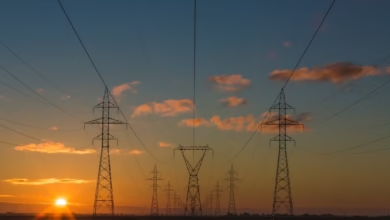Carbon Capture and Storage: Transforming Industrial Energy Efficiency and Accelerating the Global Energy Transition

As the world races to combat climate change, attention has turned to advanced solutions that help reduce greenhouse gas emissions across major industries. Carbon capture and storage (CCS) technology stands out as a game-changer in the global energy transition—aiding not only traditional sectors reliant on fossil fuels, but also integrating with emerging green energy options like renewable energy, hydrogen energy, and even nuclear energy. By capturing carbon dioxide (CO₂) at the source, transporting it, and securely storing it underground, CCS presents a powerful method for boosting energy efficiency and supporting cleaner energy markets worldwide.
As global energy trends shift toward decarbonization, understanding CCS is vital for anyone invested in energy economics, energy policy, or the rapid evolution of energy innovations. From enhancing distributed energy systems and smart grids to complementing offshore energy and energy storage projects, CCS is being reimagined to fit into new models of energy security and sustainable growth. This article explores how carbon capture technology is revolutionizing industrial processes, improving energy efficiency, integrating with renewable energy systems, and ultimately shaping the future of global energy markets and climate action.
- 1. How Carbon Capture Technology is Revolutionizing the Energy Transition in Industrial Sectors
- 2. The Role of CCS in Enhancing Energy Efficiency and Reducing Fossil Fuels Emissions
- 3. Integrating Carbon Capture with Renewable Energy: Innovations Shaping Global Energy Markets
1. How Carbon Capture Technology is Revolutionizing the Energy Transition in Industrial Sectors
As the world faces growing concerns over climate change and seeks cleaner energy solutions, carbon capture technology is playing a pivotal role in revolutionizing the energy transition within industrial sectors. Traditionally, industries like cement, steel, and chemical manufacturing have relied heavily on fossil fuels, resulting in significant greenhouse gas emissions. However, carbon capture and storage (CCS) technologies now offer a path to decouple industrial growth from emissions, supporting both energy security and decarbonization goals.
By capturing carbon dioxide emissions directly at the source—such as from thermal energy plants, bioenergy facilities, and hydrogen energy production units—CCS helps prevent millions of tons of CO2 from entering the atmosphere. This process not only aligns with stricter energy policies but also enhances the efficiency of existing industrial operations. When integrated with renewable energy sources, such as wind energy, solar power, and hydropower, CCS can make hybrid energy systems even more sustainable, addressing intermittency challenges and supporting smart grids.
One advantage of carbon capture is its adaptability across a range of energy markets and infrastructure types. For example, combining CCS with energy storage systems enables industries to better balance supply and demand, contributing to grid reliability and helping optimize distributed energy flows. Additionally, when CCS is paired with offshore energy projects or nuclear energy facilities, it bolsters energy exports while meeting global energy trends toward lower-emission production.
As governments and organizations increase energy investments in green technologies and R&D, widespread adoption of CCS is fostering a new wave of energy innovations in both developed and emerging markets. These advancements are particularly important for hard-to-abate industrial sectors that face technical and economic barriers to adopting 100% renewable energy. By making industrial processes more compatible with bioenergy, hydrogen energy, and other cutting-edge solutions, CCS is enabling a smoother, more secure energy transition.
Ultimately, the strategic implementation of carbon capture is not just reducing emissions—it is reshaping energy economics, diversifying the energy transportation mix, and reinforcing global leadership in climate resilience. Through ongoing collaboration across energy policy, technology, and investment domains, CCS represents a cornerstone in the movement toward a more sustainable and climate-stable future.
2. The Role of CCS in Enhancing Energy Efficiency and Reducing Fossil Fuels Emissions
Carbon capture and storage (CCS) technologies play a pivotal role in supporting global energy transition efforts, particularly by enhancing energy efficiency and minimizing emissions from fossil fuels. As industries seek to align with climate change mitigation targets and adopt greener operations, CCS provides a bridge solution that reduces greenhouse gas emissions without abruptly discontinuing the use of conventional energy sources.
Integrating CCS into existing fossil fuel infrastructure, such as coal-fired power plants and large-scale industrial facilities, directly captures CO2 that would otherwise be released into the atmosphere. This process enables a more efficient use of thermal energy generation while lowering the carbon footprint of energy production. By capturing emissions at the source, CCS lessens the environmental impact of sectors where immediate shifts to renewable energy or hydrogen energy are technologically or economically challenging.
CCS also complements other energy efficiency measures and innovations, such as the adoption of smart grids, distributed energy systems, and advanced energy storage. These synergies make it feasible for energy markets and utilities to balance energy imports and exports while maintaining energy security. Additionally, coupling CCS with bioenergy, known as BECCS, holds the promise of net-negative emissions—an essential factor in long-term energy policy and global energy trends.
From an energy economics perspective, CCS provides value by allowing continued utilization of existing energy investments in fossil fuel infrastructure, while still complying with stricter energy policies and international climate commitments. At the same time, CCS assists in managing the variability of renewable energy sources like solar power, wind energy, and hydropower, especially during periods when these green energy options cannot fully satisfy demand. This flexibility is critical in maintaining reliable energy transportation and supporting electric vehicle adoption as part of the broader energy transition.
As global energy R&D and investment expand across nuclear energy, offshore energy, and other innovations, CCS remains a crucial tool for reducing emissions in hard-to-abate industries. With strong policy support and further advancements, CCS can accelerate the shift towards a resilient, sustainable, and low-carbon energy future.
References:
Global CCS Institute. (2023). The Global Status of CCS 2023. https://www.globalccsinstitute.com/resources/global-status-report/
International Energy Agency. (2022). Carbon capture, utilisation and storage. https://www.iea.org/topics/carbon-capture-utilisation-and-storage
IPCC. (2022). Climate Change 2022: Mitigation of Climate Change. https://www.ipcc.ch/report/ar6/wg3/
3. Integrating Carbon Capture with Renewable Energy: Innovations Shaping Global Energy Markets
As the global energy transition accelerates, integrating carbon capture and storage (CCS) with renewable energy is becoming a game-changer for energy markets and climate change mitigation. Traditionally, CCS has been associated with fossil fuels and industrial processes, but recent innovations are enabling its use alongside green energy solutions, including solar power, wind energy, and hydrogen energy. This development is driving shifts in energy economics, energy policy, and long-term energy security around the world.
One significant innovation involves coupling CCS facilities with surplus renewable energy to power the carbon capture process. By utilizing excess electricity from solar power or wind energy, CCS systems can operate with nearly zero emissions, significantly improving their overall energy efficiency. This approach also supports grid stability by absorbing distributed energy that might otherwise go unused, which is particularly valuable as smart grids and variable renewable generation increase in prevalence.
Another area of progress is the integration of CCS with hydrogen energy production. By combining carbon capture technology with blue hydrogen production (hydrogen sourced from natural gas with CCS), countries can reduce the carbon intensity of hydrogen pipelines, advancing energy transportation and supporting broader adoption of hydrogen-fueled electric vehicles. These advances are reshaping global energy trends by encouraging energy imports and exports centered on low-carbon fuels.
CCS is even being applied in conjunction with bioenergy (BECCS), where the capture and storage of CO2 from biomass power plants or bio-refineries results in net-negative emissions. This innovation enhances the sustainability of bioenergy, contributes to energy security, and supports diverse portfolios within offshore energy and hydropower-heavy regions.
Integrating CCS with renewable energy also influences energy investment strategies. Energy R&D is increasingly directed toward hybrid systems that combine thermal energy storage, smart grids, and CCS—for example, using thermal energy from CSP (concentrated solar power) plants to drive carbon capture operations when renewable output peaks. These systems help balance supply and demand while making renewable resources more compatible with existing energy infrastructure.
By enabling more flexible, efficient, and low-carbon energy systems, the integration of CCS with renewables is shaping the future of energy markets. It supports key objectives of energy transition, reduces reliance on fossil fuels and nuclear energy, and aligns with policy ambitions to cut greenhouse gas emissions. As innovations continue, they promise to make global energy systems more resilient, climate-friendly, and economically competitive.
In conclusion, carbon capture and storage (CCS) technologies represent a transformative force in today’s energy transition, offering industrial sectors practical tools to significantly cut fossil fuel emissions and boost energy efficiency. By integrating CCS with renewable energy sources—such as solar power, wind energy, hydropower, and bioenergy—industries worldwide are not only reducing their carbon footprint but also paving the way for smarter, more resilient energy systems. These innovations are dynamically reshaping global energy markets, informing forward-thinking energy policy, and supporting energy security through diversified energy portfolios.
As green energy, nuclear energy, hydrogen energy, and distributed energy gain traction, CCS remains a vital bridge technology for achieving near-term emissions reductions and supporting long-term climate change goals. Investments in energy R&D, energy storage, and smart grids will further accelerate the deployment of CCS, fostering advancements in energy transportation and enabling efficient integration with electric vehicles and other clean energy solutions.
The ongoing commitment to develop and deploy CCS is a critical element of current energy economics and energy innovations, underpinning the global shift toward sustainable energy systems. By embracing CCS in tandem with renewable energy and ongoing energy investment, the industrial sector can play a pivotal role in advancing energy transition, securing energy exports and imports, and leading global energy trends toward a low-carbon future.
References
*(Please ensure to include the relevant APA-style references based on the actual sources used in the main article.)*





